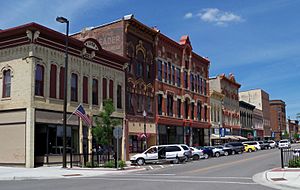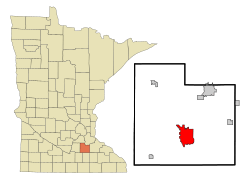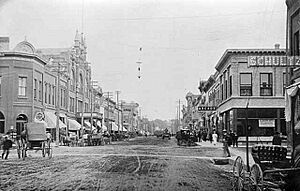Faribault, Minnesota facts for kids
Quick facts for kids
Faribault
|
||
|---|---|---|

Buildings in downtown Faribault
|
||
|
||
| Nickname(s):
"Faribo”, “Athens of the West"
|
||
| Motto(s):
"Small Town Pride, Big City Opportunities"
|
||

|
||
| Country | United States | |
| State | Minnesota | |
| County | Rice | |
| Founded | February 1855 | |
| Incorporated | February 29, 1872 | |
| Area | ||
| • Total | 15.78 sq mi (40.86 km2) | |
| • Land | 15.50 sq mi (40.15 km2) | |
| • Water | 0.28 sq mi (0.71 km2) | |
| Elevation | 981 ft (299 m) | |
| Population
(2020)
|
||
| • Total | 24,453 | |
| • Estimate
(2022)
|
24,518 | |
| • Density | 1,577.41/sq mi (609.03/km2) | |
| Time zone | UTC-6 (Central (CST)) | |
| • Summer (DST) | UTC-5 (CDT) | |
| ZIP code |
55021
|
|
| Area code(s) | 507 | |
| FIPS code | 27-20546 | |
| GNIS feature ID | 2394742 | |
| Sales tax | 7.375% | |
Faribault (pronounced FAIR-boh) is a city in Minnesota, United States. It is the main city and county seat of Rice County. In 2020, about 24,453 people lived there. Faribault is located about 50 miles (80 km) south of the big cities of Minneapolis–Saint Paul.
Major highways like Interstate 35 and Minnesota State Highways 3, 21, and 60 help people travel to and from the city. Faribault sits where the Cannon River and the Straight River meet.
Contents
Discovering Faribault's Past
Faribault is known as one of the oldest and most historic places in Minnesota. People started settling and trading here even before Minnesota became a U.S. territory.
Who Lived Here First?
Before 1745, the Wahpekute band of the Dakotah people lived in this area. Later, they moved south after some conflicts with the Ojibwe tribe over land.
How Faribault Got Its Name
The city is named after Alexander Faribault. He was the son of a French-Canadian fur trader and a Dakotah woman. Alexander helped a lot with the early settlement of the area.
In 1826, he set up a fur trading post on the Cannon River. This trading post became very popular. By 1834, it moved to the Straight River, which is where Faribault is today.
Alexander Faribault knew the Dakota language and culture well. This helped him build good relationships with the Wahpekute people. He even helped them settle in the area again. This friendship was very important for the trading post to succeed. It also made it safe for new settlers to travel there. The Dakota people called this place "Adek," which was short for Alex.
Some people believe the city might also be named after Alexander's father, Jean-Baptiste Faribault.
Faribault's First Buildings and Growth
The Alexander Faribault House was built in 1853. It cost $4,000, which was a lot of money back then. This house is the oldest wooden building in the area. It still stands in its original spot near Faribault's historic downtown.
After this first building, the settlement grew very quickly. In early 1854, the first sawmill powered by steam was built. This helped the town grow from 20 buildings to over 250 in just one year!
Faribault's growth was also helped by new roads. These roads connected the town to other settlements and trading posts in Iowa and Minnesota Territory. Mail service also became available, and new schools and churches were built.
The city of Faribault was officially mapped out in 1855. It received its official city charter in 1872.
Exploring Faribault's Location
Faribault covers about 15.67 square miles (40.59 square kilometers). Most of this area is land, with a small part being water. The Straight River and the Cannon River meet right inside the city.
Nearby, you can find Sakatah Lake State Park and Nerstrand-Big Woods State Park. These are great places to enjoy nature.
Highways and Trails
Interstate 35 runs along the western side of Faribault. This highway helps people travel around the region. Before I-35 was finished, all traffic went through the city. This brought many customers to local shops.
After I-35 was completed around 1975, through traffic started to bypass Faribault. This changed how businesses operated.
An old swimming pool called White Sands used to be here. It was known as "Minnesota's Largest Outdoor Swimming Pool." Now, this area is the White Sands Dog Park. It's also the start of the Sakatah Singing Hills Trail, which goes to Mankato. Another trail, the Mill Towns Trail, is planned to connect to Northfield. The park has parking, restrooms, and a shelter.
What's the Weather Like in Faribault?
Faribault has a climate with warm summers and cold winters. Here's a quick look at the average temperatures and precipitation:
- Winter (December-February): Coldest months with average temperatures around 14-28°F (-10 to -2°C). Snowfall is common.
- Spring (March-May): Temperatures rise, averaging 30-57°F (-1 to 14°C). More rain starts to fall.
- Summer (June-August): Warmest months, with averages around 68-71°F (20-22°C). This is when Faribault gets the most rain.
- Fall (September-November): Temperatures cool down, averaging 33-61°F (0-16°C).
The city experiences all four seasons, with clear changes in weather throughout the year.
Who Lives in Faribault?
Faribault has grown steadily over the years. In 2020, the population was 24,453 people.
Faribault's Diverse Community
In 2020, there were 8,853 households in the city. The population density was about 1,577 people per square mile.
The people living in Faribault come from many different backgrounds:
- 70.9% White
- 14.8% African American
- 0.9% Native American
- 1.4% Asian
- 0.2% Pacific Islander
- 5.4% from two or more races
About 14.5% of the population identified as Hispanic or Latino.
In 2010, there were 8,317 households. About 36.4% of these households had children under 18. The average household had 2.50 people. The average family size was 3.12 people.
The median age in Faribault was 35.4 years. This means half the people were younger than 35.4 and half were older. About 25.2% of residents were under 18 years old.
What Does Faribault Do? (Economy)
Faribault has many local shops and services, just like most small towns. It also has several light manufacturing businesses.
Downtown Revitalization
Central Avenue, the main street, is being redeveloped. Many historic buildings are being restored to their original look. The Paradise Center for the Arts is one example. It's a place for different art activities, combining the Faribault Art Center and the Faribault Area Community Theatre.
Some older businesses have closed, like Jim & Joe's Clothiers, which was open for over 125 years. Minnick's Food Market, a local grocery store, also closed after more than 60 years.
Famous Inventions and Industries
Did you know the Tilt-A-Whirl ride was invented in Faribault? Herbert Sellner, a local woodworker, created it in 1926 in his home. The first 14 Tilt-A-Whirls were built in his basement and yard. In 1927, Sellner Manufacturing opened its factory in Faribault. The ride first appeared at the Minnesota State Fair that same year.
The Faribault Woolen Mills started in 1865. It kept running until 2009 and then reopened in 2011. It's one of the few places left in the U.S. that takes raw wool and turns it into finished products.
SAGE Electrochromics, a company that makes special window glass, is also based in Faribault.
Important Places in Faribault
Learning and Education
Faribault has a public school district called Faribault Public Schools. It includes an early childhood center, four elementary schools, a middle school, and Faribault High School. There are also centers for adult education. Students come from Faribault and nearby areas.
The Minnesota State Academies for the Deaf and for the Blind are located in Faribault. They also have the State Library for the Blind. Noyes Hall, a beautiful old building on the campus of the Minnesota State Academy for the Deaf, is a historic landmark.
Shattuck-Saint Mary's is a special boarding school. It's famous for its hockey program, which has won many national championships. Many of its alumni have gone on to play in the NHL and for Olympic teams.
South Central Community College also has a campus in Faribault.
Other Key Institutions
- The Thomas Scott Buckham Memorial Library is the city's public library.
- The Minnesota Correctional Facility - Faribault is a state prison. It is located on the grounds of a former mental hospital.
- The River Bend Nature Center is a large, 750-acre nature center. It's a great place to explore and learn about nature.
- The Rice County Historical Society is also in Faribault. It helps preserve the history of the county.
Faribault in the News and on the Air
The main daily newspaper for the area is the Faribault Daily News.
Radio Stations You Can Hear
- FM Radio:
* 95.9 FM, KQCL, plays classic rock music. * 107.5 FM, KBGY, plays classic country music.
- AM Radio:
* 920 AM, KDHL, also plays classic country music.
Famous People from Faribault
Many notable individuals have connections to Faribault:
- Howard Bachrach (1920–2008), a scientist who studied viruses.
- George Ballis (1925–2010), a photographer and activist.
- Deming Bronson (1894–1957), a recipient of the Medal of Honor.
- Stephen Chatman, a Canadian composer born in Faribault.
- Richard Cross, an opera singer.
- Mark Dusbabek, a former NFL player.
- Patrick Eaves, an NHL player who grew up in Faribault.
- Tom Lieb (1899–1962), an Olympic athlete and coach.
- Mike Mason, a former baseball pitcher.
- Diana E. Murphy (1934–2018), a United States judge.
- Jake Petricka, a Major League Baseball pitcher.
- Bruce Smith, a winner of the 1941 Heisman Trophy.
- Elizabeth Strohfus, a famous aviator.
- Wendy Shon, a member of the South Korean group Red Velvet, lived here.
- Henry Benjamin Whipple, the first Episcopal bishop of Minnesota.
- Kuoth Wiel (1990–), a model and actress.
- Raphael Louis Zengel, a Faribault-born winner of the Victoria Cross.
Images for kids
See also
 In Spanish: Faribault (Minnesota) para niños
In Spanish: Faribault (Minnesota) para niños







